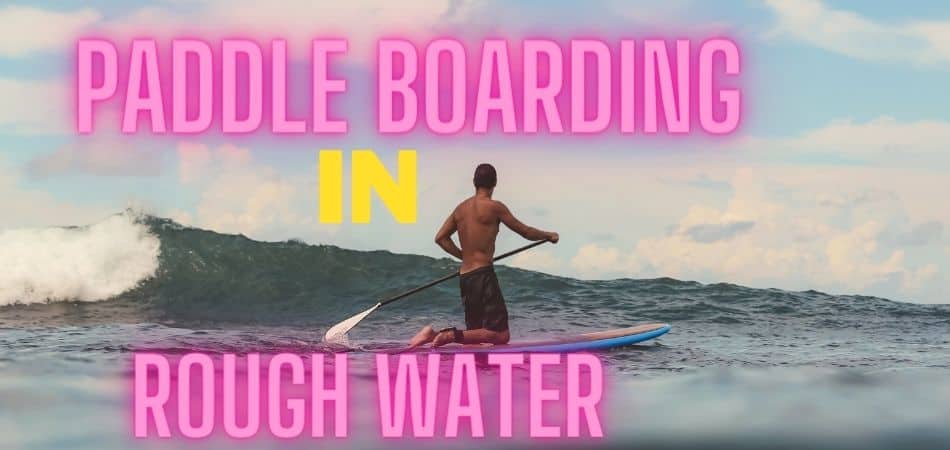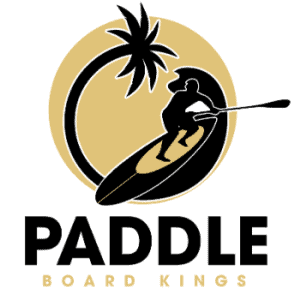Paddle boarding is a water sport that involves using a paddle board or a surfboard, and people mostly use their hands to propel them. It’s great for beginners because it doesn’t require much skill or training to get started. But what if the water is choppy?
Paddle boarders also have to deal with waves and rough waters. So how do you paddle board in such imperfect conditions? It’s essential to understand everything about paddling in rough waters, including tips on dealing with waves and choppy seas.

Tips on Paddle Boarding on Wavy and Choppy Waters
Choppy water is a term used to describe irregular waters due to effects such as wind. It can be challenging for inexperienced board paddlers to navigate choppy waters. This challenge is the same for those paddle boarding in wavy waters or paddle boarding in the ocean.
For this reason, there are specific tips that are essential to help board paddlers safely navigate these difficulties.
1. Remain Calm
It’s important to stay relaxed when riding on choppy waters. This will help keep your muscles loose and prevent you from getting tense, which can lead to mistakes.
2. Closeness to the Shore
Stay close to shore when paddling in rough waters. Doing so will give you a place to swim if anything wrong does happen.
3. Be Keen and Observant
Be aware of your surroundings when paddling in rough waters. Keep an eye out for other boats, rocks, and other obstacles that could cause problems.
4. Look Ahead
Focus your eyes on the horizon, and don’t look down at the water. This will help you stay balanced and avoid being thrown off of your paddleboard.
5. Wear Protective Gear
Always wear protective gear like gloves and shoes while you’re out paddling in rough waters. Moreover, headgear is crucial in these types of waters. This precaution will help you avoid injury from the rocks, shells, and other hurdles that may be in the water.
6. Observe the Waves before Going into the Water
Consider the waves before you enter the waters. You should also avoid taking on waves that you aren’t confident in your ability to manage. Furthermore, ensure that your leash is attached to your board so that it does not get away from you.
7. Paddle Hard When Necessary
Use short, fast strokes with plenty of strength behind them if you need to speed up or get more power. This tip will help you catch up to the wave and ride it all the way through.
Wavy and Choppy Water Paddle boarding Techniques
- A-Frame Draw / S-Hauling Technique
The “A-Frame” technique helps catch eddy lines and can be important when paddling in high winds or on rivers with strong currents.
To perform this paddle technique, the board needs to be facing upstream of the direction you are moving. Then, the downstream edge is lifted out of the water to make an ‘A’ shape similar to a triangle.
This motion will cause your board to turn into the current. As a result, you’ll have more control over where you want to go without having too much speed behind your movements which could lead to tipping over. Use a quick draw stroke backward to stop your board after turning in towards shore.
- How to Master this Technique
Practice turning in with the current on small rivers or creeks when you are alone. It will take time for you to understand how far out of the water needs to be lifted before using a draw stroke for it not to cause too much speed, which could result in tipping over.
Correctly done A-Frame draws can help provide more control during choppy conditions if paddling alongside strong currents that need maneuvering through rocks.
- Low Brace and High Brace Techniques
The low brace and high brace are two techniques that are helpful when you feel like you are about to lose balance or if you have lost balance and started to tip over.
Quickly place one hand on the deck of your SUP and thrust the other downwards into the water while keeping your arm close to your body. This motion will help push against the paddle blade and create resistance which will stop you from flipping over or capsizing.
Ensure you twist your body in the opposite direction of the way you’re tipping while pushing off with your hand from the deck. This is important for the effective execution of this technique by creating more resistance and stability.
Similarly, the high brace works like the low brace. The only difference is that you use both hands to hold onto the rail of your SUP instead of one hand on the deck. This technique works best when there is a lot of force or current pushing against you, as it will give you more stability and prevent flipping over.
- Hip Snap Technique
The hip snap paddle technique is used when trying to get out of a dangerous situation quickly. Alternatively, you can use it if you need to speed up quickly while paddling downstream.
- Executing this Technique
Thrust your body weight to one side of the board while holding onto the rail with only one hand. Afterward, use a quick draw stroke backward followed by another forward drawing motion to propel yourself out of harm’s way or towards safety.
This is necessary once you are off-balance on that side of the board. Moreover, ensure that you keep pulling back on your Stand-Up Paddleboard (SUP) when performing these movements to prevent it from slipping away from you too fast.
Hip snaps can be an effective technique during high winds, and choppy waters where turning around is crucial for survival.
- Pivot Turn Technique
The pivot turn maneuver works best when you need to turn your board around to avoid an obstacle quickly.
Performing this move involves putting all your weight on one side of the SUP. Consequently, it would be best to keep the rail closest to the water gripped with your hand.
Then, use that same hand to push off and thrust the board in the opposite direction while angling it sideways. Doing so will cause your SUP to spin quickly on its axis like a top.
Make sure that you keep your body close to the deck; otherwise, you might end up flipping over.
- The Eskimo Roll Technique
The Eskimo roll is, without a doubt, one of the most effective techniques when attempting to get past rough wavy waters.
It involves getting into the kneeling position on your board. Once in this stance, lean slightly forward and put your weight on the front of the board while keeping your back straight. Then, thrust the paddle blade into the water and pull it backwards towards you using both hands.
As you do this, keep your arms close to your body. This motion will cause the board to flip over such that you are now lying flat on it with the paddle still on your hands. At this point, use a sculling motion with the paddle to propel yourself back to shore or safety.
The Eskimo roll can be a lifesaver when in danger and can help you get back to shore quickly, even in the roughest waters. However, it is important to note that this technique takes a lot of practice and should not be attempted until you are confident with your balance and swimming abilities.
